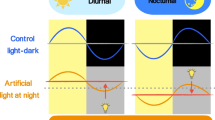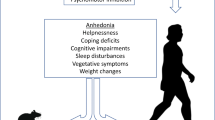Abstract
Roman high (RHA/Verh)- and low (RLA/Verh)-avoidance rats are selected and bred for rapid versus nonacquisition of two-way, active avoidance behavior in the shuttle box. RHA/Verh rats generally show a more active coping style than do their RLA/Verh counterparts when exposed to various environmental challenges. The central nucleus of the amygdala (CeA) is known to be involved in the regulation of autonomic, neuroendocrine, and behavioral responses to stress. Its involvement in the selection of coping strategies has also been suggested. Corticotropin-releasing hormone (CRH) seems to be one of the key neurohormones in the control of CeA output. Neuroanatomical studies have revealed that the majority of CRH fibers from the CeA have direct connections with autonomic regulatory nuclei in the brain-stem, e.g. lateral parabrachial nucleus (lPB). The effects of CRH (30 ng) on modulating CeA activity were studied by infusion of CRH into the CeA during conditioned stress (inescapable foot-shocks) in RHA/Verh and RLA/Verh male rats. Heart-rate responses after CRH treatment were not changed in either line. However, distinctly different behavioral responses were seen after CRH infusion into the CeA of both rat lines. A decrease in immobility responses was seen in both RHA/Verh and RLA/Verh rats, while an increase in exploration was observed in RHA/Verh rats only in the conditioned stress situation. Rearing levels were increased in the RHA/Verh rats, whereas they were decreased in the RLA/Verh animals. As a result of CRH infusion, the number of FOS immunoreactive cells in the lPB of RLA/Verh rats was decreased, whereas an opposite response was found in RHA/Verh rats. These results indicate that the CRH system of the CeA connected with output brain-stem areas is differentially involved in the cardiovascular and behavioral responses of these rats having different coping styles.
Similar content being viewed by others
REFERENCES
Ader, R., Weijnen, J. A. W. N., and Moleman, P. (1972). Retention of a passive avoidance response as a function of the intensity and duration of electric shock. Psychon. Sci. 26:125–128.
Andreae, L. C., and Herbert, J. (1993). Expression of c-fos in restricted areas of the basal forebrain and brainstem following single or combined intraventricular infusions of vasopressin and corticotropin-releasing factor. Neuroscience 53:735–748.
Aubry, J. M., Bartanusz, V., Driscoll, P., Schulz, P., Steimer, T., and Kiss, J. Z. (1995). Corticotropin-releasing factor and vasopressin mRNA levels in Roman high-and low-avoidance rats: Response to open-field exposure. Neuroendocrinology 61:89–97.
Bakke, H. K., Bogsnes, A., and Murison, R. (1990). Studies on the interaction between icv effects of CRF and CNS noradrenaline depletion. Physiol. Behav 47:1253–1260.
Bohus, B. (1974). Telemetred heart rate responses of the rat during free and learned behavior. Biotelemetry 1:193–201.
Bohus, B., Benus, R. F., Fokkema, D. S., Koolhaas, J. M., Nyakas, C., van Oortmerssen, G. A., Prins, A. J. A., de Ruiter, A. J. H., Scheurink, A. J. W., and Steffens, A. B. (1987). Neuroendocrine states and behavioral and physiological stress responses. In de Kloet, E. R., Wiegant, V. M., and de Wied, D. (eds.), Progress in Brain Research: Neuropeptides and Brain Function, Elsevier, Amsterdam, New York, Oxford, pp. 47–70.
Britton, D. R., Koob, G. F., Rivier, J., and Vale, W. (1982). Intraventricular corticotropin-releasing factor enhances behavioral effects of novelty. Life Sci. 31:363–367.
Brown, M. R., and Fisher, L. A. (1985). Corticotropin-releasing factor: effects on the autonomic nervous system and visceral systems. Fed. Proc. 44:243–248.
Castanon, N., and Mormède, P. (1994). Psychobiogenetics—Adapted tools for the study of the coupling between behavioral and neuroendocrine traits of emotional reactivity. Psychoneuroendocrinology 19:257–282.
Castanon, N., Dulluc, J., LeMoal, M., and Mormède, P. (1994). Maturation of the behavioral and neuroendocrine differences between the Roman rat lines. Physiol. Behav. 55:775–782.
Chaouloff, F., Castanon, N., and Mormède, P. (1994). Paradoxical differences in animal models of anxiety among the Roman rat lines. Neurosci. Lett. 182:217–221.
D'Angio, M., Serrano, A., Driscoll, P., and Scatton, B. (1988). Stressful environmental stimuli increase extracellular DOPAC levels in the prefrontal cortex of hypoemotional (Roman high-avoidance) but not hyperemotional (Roman low-avoidance) rats. An in vivo voltametric study. Brain Res. 451:237–247.
Diamant, M., and De Wied, D. (1991). Autonomic and behavioral effects of centrally administered corticotropin-releasing factor in rats. Endocrinology 129:446–454.
Driscoll, P., and Battig, K. (1982). Behavioral, emotional and neurochemical profiles in rats selected for extreme differences in active, two-way avoidance performance. In Lieblich, I. (ed.), Genetics of the Brain, Elsevier, Amsterdam, pp. 95–123.
Driscoll, P., Dedek, J., D'Angio, M., Claustre, Y., and Scatton, B. (1990). A genetically-based model for divergent stress responses: behavioral, neurochemical and hormonal aspects. In Pliska, V., and Stranzinger, G. (eds.), Farm Animals in Biomedical Research, Verlag Paul Parey, Hamburg and Berlin, pp. 97–107.
Dunn, A. J., and Berridge, C. W. (1990). Physiological and behavioral responses to corticotropin-releasing factor administration: Is CRF a mediator of anxiety or stress responses? Brain Res. Rev. 15:71–100.
Ferre, P., Fernandez-Teruel, A., Escorihuela, R. M., Driscoll, P., Corda, M. G., Giorgi, O. and Tobena, A. (1995). Behavior of the Roman/Verh High-and Low-Avoidance rat lines in anxiety tests: Relationship with defecation and self-grooming. Physiol. Behav. 58:1209–1213.
Fisher, L. A. (1988). Corticotropin-releasing factor: Central nervous system effects on baroreflex control of heart rate. Life Sci. 42:2645–2649.
Fisher, L. A., and Brown, M. R. (1991). Central regulation of stress responses: Regulation of the autonomic nervous system and visceral function by corticotropin releasing factor-41. Bailiere's Clinical Endocrinology and Metabolism, pp. 35–50.
Koolhaas, J. M. (1994). Individual coping strategies and vulnerability to stress pathology. Homeostasis 35:24–27.
Koolhaas, J. M., and Bohus, B. (1991). Coping strategies and cardiovascular risk: A study of rats and mice. In Appels, A. (ed.), Behavioral Observations in Cardiovascular Research, Swets & Zeitlinger B.V., Amsterdam/Lisse, pp. 45–58.
Korte, S. M., Bouws, G. A. H., and Bohus, B. (1993). Central actions of corticotropin-releasing hormone (CRH) on behavioral, neuroendocrine, and cardiovascular regulation—Brain corticoid receptor involvement. Horm. Behav. 27:167–183.
Korte, S. M., KorteBouws, G. A. H., Bohus, B., and Koob, G. F. (1994). Effect of corticotropin-releasing factor antagonist on behavioural and neuroendocrine responses during exposure to defensive burying paradigm in rats. Physiol. Behav. 56:115–120.
Kurosawa, M., Sato, A., Swenson, R. S., and Takahashi, Y. (1986). Sympatho-adrenal medullary functions in response to intracerebroventricular injected corticotropin-releasing factor in anesthetized rats. Brain Res. 367:250–257.
Meerlo, P., Overkamp, G. J. F., and Koolhaas, J. M. (1997). Behavioural and physiological consequences of a single social defeat in Roman high and low avoidance rats. Psychoneuroendocrinology 22:155–168.
Owens, M. J., and Nemeroff, C. B. (1991). Physiology and pharmacology of corticotropin-releasing factor. Pharmacol. Rev. 43(4):425–473.
Paxinos, G., and Watson, C. (1982). The Rat Brain in Stereotaxic Coordinates, Academic Press, New York.
Roozendaal, B., Koolhaas, J. M., and Bohus, B. (1993). Posttraining norepinephrine infusion into the central amygdala differentially enhances later retention in Roman high-avoidance and low-avoidance rats. Behav. Neurosci. 107:575–57---.
Roozendaal, B., Wiersma, A., Driscoll, P., Koolhaas, J. M., and Bohus, B. (1992). Vasopressinergic modulation of stress responses in the central amygdala of the Roman high-avoidance and low-avoidance rat. Brain Res. 596:35–40.
Sherman, J. E., and Kalin, N. H. (1988). Icv-CRH alters stress-induced freezing behavior without affecting pain sensitivity. Pharmacol. Biochem. Behav. 30:801–807.
Spadaro, F., Berridge, C. W., Baldwin, H. A., and Dunn, A. J. (1990). Corticotropin-releasing factor acts via a third-ventricle site to reduce exploratory behavior in rats. Pharmacol. Biochem. Behav. 36:305–309.
Steimer, Th., Driscoll, P., and Schulz, P. (1997). Brain metabolism of progesterone, coping behaviour and emotional reactivity in male rats from two psychogenetically selected lines. J. Neuroendocrinol. 9:169–175.
Sutton, R. E., Koob, G. F., LeMoal, M., Rivier, J., and Vale, W. (1982). Corticotropin releasing factor produces behavioural activation in rats. Nature 297:331–333.
Veldhuis, H. D., and De Wied, D. (1984). Differential behavioral actions of corticotropin-releasing factor (CRF). Pharmacol. Biochem. Behav. 21:707–713.
Wiersma, A., Bohus, B., and Koolhaas, J. M. (1993). Corticotropin-releasing hormone microinfusion in the central amygdala diminishes a cardiac parasympathetic outflow under stress-free conditions. Brain Res. 625:219–227.
Wiersma, A., Baauw, A. D., Bohus, B., and Koolhaas, J. M. (1995). Behavioural activation produced by CRH but not α-helical CRH (CRH-receptor antagonist) when microinfused into the central nucleus of the amygdala under stress-free conditions. Psychoneuroendocrinology 20:423–432.
Wiersma, A., Bohus, B., and Koolhaas, J. M. (1996). Corticotropin-releasing hormone microinfusion in the central amygdala enhances active behaviour responses in the conditioned defensive burying paradigm. Stress 1:113–122.
Wiersma, A., Konsman, J. P., Knollema, S., Bohus, B., and Koolhaas, J. M. (1997a). Differential cardiac, behavioural, and neuroanatomical modulation of central amygdaloid corticotropin-releasing hormone mechanisms in the Roman high-avoidance and low-avoidance rats under stress-free conditions. Psychoneuroendocrinology (in press).
Wiersma, A., Tuinstra, T., and Koolhaas, J. M. (1997b). Corticotropin-releasing hormone into the basolateral nucleus of the amygdala does not induce any change in cardiovascular, neuroendocrine or behavioural output in a stress-free condition. Brain Res. (in press).
Willig, F., M'Harzi, M., Bardelay, C., Viet, D., and Delacour, J. (1991). Roman strains as a psychogenetic model for the study of working memory: Behavioral and biochemical data. Pharmacol. Biochem. Behav. 40:7–16.
Author information
Authors and Affiliations
Corresponding author
Rights and permissions
About this article
Cite this article
Wiersma, A., Knollema, S., Konsman, J.P. et al. Corticotropin-Releasing Hormone Modulation of a Conditioned Stress Response in the Central Amygdala of Roman High (RHA/Verh)-Avoidance and Low (RLA/Verh)-Avoidance Rats. Behav Genet 27, 547–555 (1997). https://doi.org/10.1023/A:1021457015482
Issue Date:
DOI: https://doi.org/10.1023/A:1021457015482




